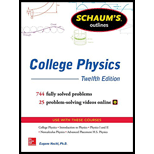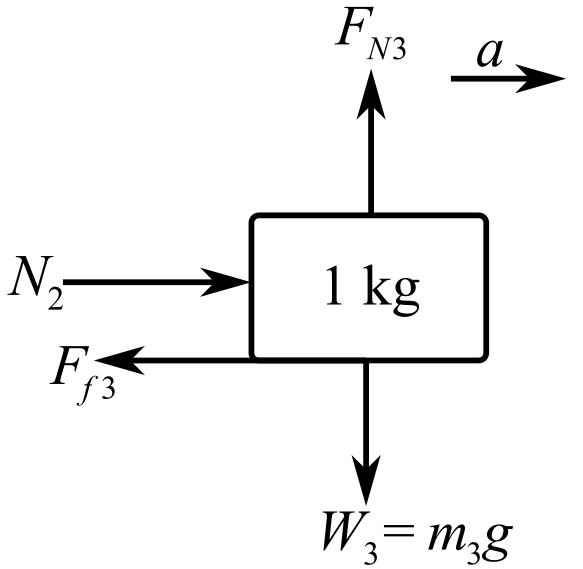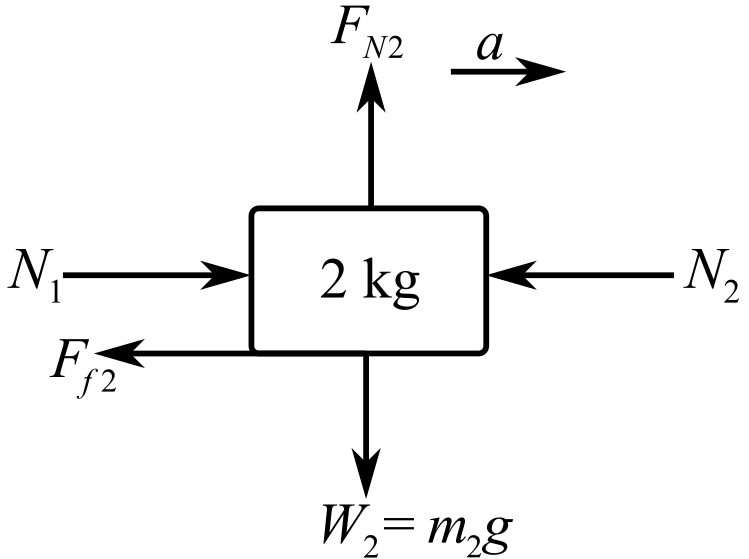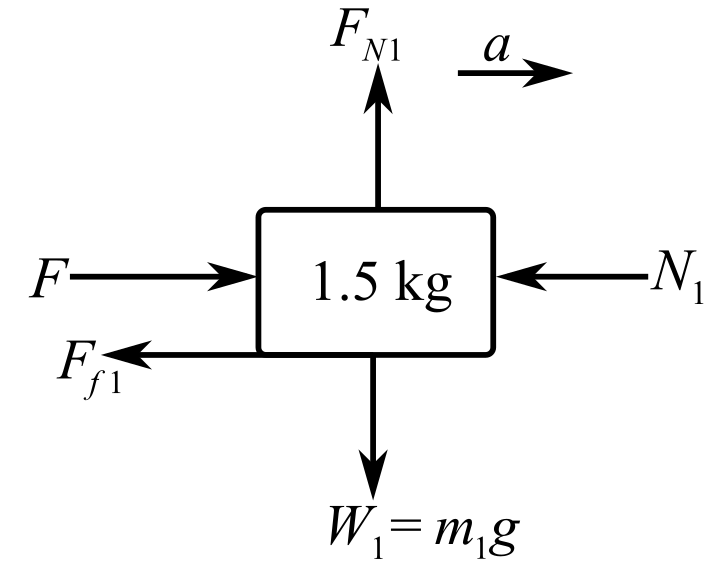
In Fig. 3-28, how large a force F is needed to give the blocks an acceleration of 3.0
m/s2 if the coefficient of kinetic friction between blocks and table is 0.20? How large
a force does the 1.50-kg block then exert on the 2.0-kg block?
![Chapter 3, Problem 79SP, 3.79 [III] In Fig. 3-28, how large a force F is needed to give the blocks an acceleration of 3.0](https://content.bartleby.com/tbms-images/9781259587399/Chapter-3/images/87399-3-79sp-question-digital_image53.png)
The maximum force
Answer to Problem 79SP
Solution:
Explanation of Solution
Given data:
Arrangement of the blocks of mass
Coefficient of friction between blocks and table is
The needed acceleration of the blocksis
Formula used:
Write the expression for the first condition of the force’s equilibrium:
Here,
From the Newton’ s second law of the motion, the expression of the force is
Here,
Write the expression for the friction force:
Here,
Sign convention: Consider the direction of the upward forces is positive and the direction of the downward forces is negative. Also, consider the leftward force as negative and rightward forces are positive.
Explanation:
Draw the free body diagram of a

In
Recall the expression for the first condition of the force’s equilibrium:
From the free body diagram:
Substitute
Recall the expression for the friction force:
Substitute
Recall the expression for Newton’s second law of the motion:
From free body diagram, the force equation is
Substitute
Draw the free body diagram of the all the blocks:

In
Now, consider the
From free body diagram:
Substitute
Recall the expression of the friction force:
Substitute
Recall the expression for Newton’s second law of the motion:
From free body diagram:
Substitute
Draw the free body diagram of the all the blocks:

In the above diagram,
Now, consider the
From free body diagram:
Substitute
Recall the expression for the friction force:
Substitute
Recall the expression for Newton’s second law of the motion:
From free body diagram:
Substitute
Conclusion:
Therefore, the required force
Want to see more full solutions like this?
Chapter 3 Solutions
Schaum's Outline of College Physics, Twelfth Edition (Schaum's Outlines)
- a box of books weighing 30-kg is pushed across the floor of an apartment by a force of 300 n exerted downward at an angle of 35.2 below the horizontal. if the coefficient of kinetic friction between box and floor is 0.570, how long does it take to move the box 3.00 m, starting from rest?arrow_forwardA force of 300 N is applied to a 20 kg crate at an angle of 30o below the horizontal. Determine the acceleration of the crate as it moves along the horizontal surface. The coefficient of friction between the crate and the surface µk is 0.50.arrow_forwardIn Fig. 3-19, the weights of the objects are 200 N and 300 N. The pulleys are essentially friction- less and massless. Pulley P₁ has a stationary axle, but pulley P₂ is free to move up and down. Find the tensions Fri and Fr2 and the acceleration of each body. P₁ F12 A 200 N Fri B 300 Narrow_forward
- BodyA in Fig. 6-33 weighs 102 N, and body B weighs 32 N. The coefficients of friction between A and the incline are us =0.56 and uk=0.25. Angle 0 is 40°. Let the positive direction of an x axis be up the incline. In unit-vector notation, what is the acceleration of A if A is initially (a) at rest, (b) moving up the incline, and (c) moving down the incline Frictionless, massless pulleyarrow_forwardTwo blocks A and B are released from rest on a 30° incline when they are 13 meters apart. The coefficient of friction under the upper block A is 0.20 and that under the lower block B is 0.40. Compute the elapsed time in seconds until the blocks touch.arrow_forwardA 37-kg crate is placed on an inclined ramp.When the angle the ramp makes with the horizontal is increasedto 23°, the crate begins to slide downward. (a) What is the coefficient of static friction between the crate and the ramp? (b) At whatangle does the crate begin to slide if its mass is doubled?arrow_forward
- A force of 600 N is applied on a block of mass M to pull it at a constant velocity up the incline at an angle of 30degrees with the horizontal. The coefficient of kinetic friction between the surface of the incline and the block is 0.5. Calculate the mass of the block.arrow_forwardTo move a large crate of mass 32.0 kg across a rough floor, with coefficient of kinetic friction between the crate and the floor is k = 0.45, you pull on it with a Force P at an angle of 30o above the horizontal and some else also pushes on the crate with a force F at an angle 45o below the horizontal. (The applied forces, F & P, on the crate starts it moving.) (a) Find the Normal force acting on the crate. (b) Find the acceleration of the crate if the applied force is F = 130 N & P = 300 N.arrow_forwarda mass is given an initial velocity v0= 3.4ms up a 15 degree incline. a) if the coefficient of kinetic friction between the mass and the incline is 0.25, how long before the mass comes to rest? b) if the coefficient of static friction is 0.29, will the mass slide back down the incline?arrow_forward
- 15-7. Crates A and B weigh 100 lb and 50 lb, respectively. If they start from rest, determine their speed when t = 5 s. Also, find the force exerted by crate A on crate B during the motion. The coefficient of kinetic friction between the crates and the ground is µ = 0.25. A P = 50 lbarrow_forwardA crate of mass m falls off a truck and initially travels at a speed vo after it hits the ground. Assuming the road is perfectly horizontal, and the coefficient of kinetic friction between the road and the crate is μ, how far down the road will the crate slide before coming to rest?arrow_forwardTHREE 5-KG PACKAGES A, B, AND C ARE PLACED ON A CONVEYOR BELT THAT IS AT REST. BETWEEN THE BELT AND BOTH PACKAGES A AND C THE COEFFICIENTS OF FRICTION ARE us = BETWEEN PACKAGE B AND THE BELT THE COEFFICIENTS ARE us = 0.30 AND uK = 0.20%3; 0.15 AND H = 0.10. THE PACKAGES ARE PLACED ON THE BELT SO THAT THEY ARE IN CONTACT WITH EACH OTHER AND AT REST. DETERMINE WHICH, IF ANY, OF THE PACKAGES WILL MOVE AND THE FRICTION FORCE ACTING ON EACH PACKAGE. %3D 5 kg skg 5 kgarrow_forward
 Classical Dynamics of Particles and SystemsPhysicsISBN:9780534408961Author:Stephen T. Thornton, Jerry B. MarionPublisher:Cengage Learning
Classical Dynamics of Particles and SystemsPhysicsISBN:9780534408961Author:Stephen T. Thornton, Jerry B. MarionPublisher:Cengage Learning
